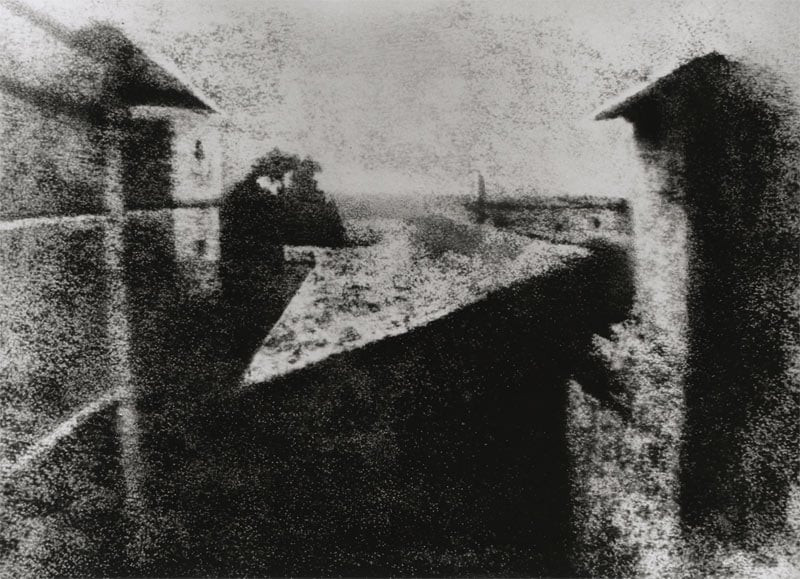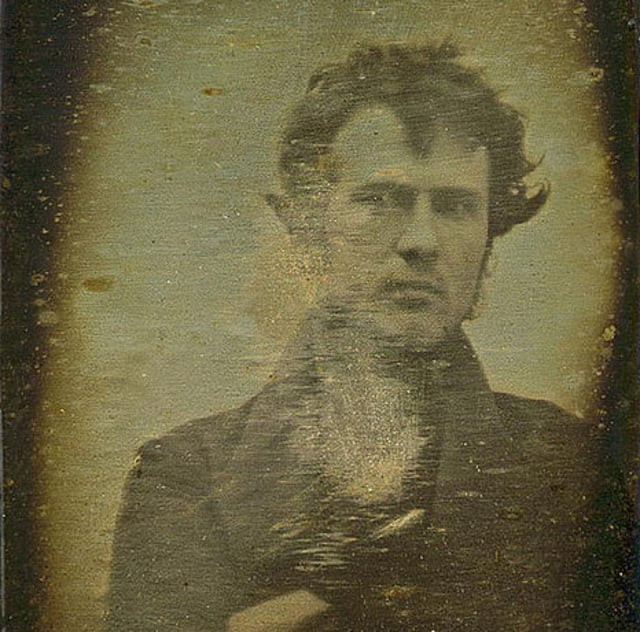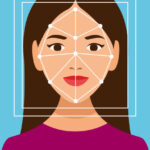The first photo ever taken was in 1826 by Joseph Nicéphore Niépce, a French inventor. This landmark moment in photographic history is a testament to human curiosity and the desire to capture the world around us, which dfphoto.net explores further. This photograph, often called “View from the Window at Le Gras,” marked the beginning of photography as we know it, opening doors to visual storytelling, art, and historical preservation and showcasing light sensitivity and image development. Explore innovative photo techniques, artistic inspiration, and image protection strategies.
Table of Contents
- The Genesis of Photography: Unveiling the First Photograph
- Joseph Nicéphore Niépce: The Pioneer of Photographic Art
- Heliography: The Dawn of Imaging Technology
- View from the Window at Le Gras: A Revolutionary Image
- The Daguerreotype Era: A Leap in Photography
- Early Photography and Portraiture: Capturing Humanity
- The Evolution of Color Photography: From Ribbons to Landscapes
- Photography in the Digital Age: A Paradigm Shift
- Aerial Photography: Seeing the World from Above
- Photography in Space: Capturing the Cosmos
- Photography and News: Documenting History
- The Impact of Photography on Art and Culture
- The Enduring Legacy of Early Photography
- Photography Today: Trends and Innovations
- Frequently Asked Questions (FAQs)
1. The Genesis of Photography: Unveiling the First Photograph
When Was The First Photo Ever Taken? The answer lies in the early 19th century, a period of intense scientific exploration and artistic innovation. Joseph Nicéphore Niépce successfully captured and fixed an image using a camera obscura, an event that marked the birth of photography. This breakthrough opened the door to countless possibilities and irreversibly changed how we perceive and document the world around us.
 Joseph Nicéphore Niépce's pioneering photograph showcases a rooftop view, marking a pivotal moment in imaging history
Joseph Nicéphore Niépce's pioneering photograph showcases a rooftop view, marking a pivotal moment in imaging history
2. Joseph Nicéphore Niépce: The Pioneer of Photographic Art
Who created the first photograph? Joseph Nicéphore Niépce, a French inventor with a passion for lithography, is celebrated as the father of photography. Born in 1765, Niépce dedicated years to experimenting with various chemicals and techniques to capture and preserve images permanently. His relentless pursuit of this vision culminated in the creation of the world’s first photograph, solidifying his place in history. This achievement showcases Niépce’s technical skills and innovative spirit, underscoring the importance of his contribution to art and science.
3. Heliography: The Dawn of Imaging Technology
What process did Niépce use to create the first photograph? Niépce used a process called heliography, meaning “sun drawing.” This technique involved coating a pewter plate with Bitumen of Judea, a naturally occurring asphalt. When exposed to light, the bitumen hardened in proportion to the light’s intensity. After a lengthy exposure period, the unhardened bitumen was washed away, leaving a permanent image etched on the plate. This innovative use of light-sensitive materials laid the groundwork for modern photographic processes and imaging technology.
4. View from the Window at Le Gras: A Revolutionary Image
What does the first photograph depict? “View from the Window at Le Gras,” taken in 1826, is the oldest surviving photograph. The image shows a hazy view of the buildings and countryside surrounding Niépce’s estate in Burgundy, France. While not sharp or detailed by today’s standards, this photograph is revolutionary because it proves that capturing and preserving real-world scenes was possible. This modest image holds immense historical value, representing the starting point of a visual revolution that continues to evolve.
5. The Daguerreotype Era: A Leap in Photography
How did photography evolve after Niépce’s invention? Following Niépce’s death, Louis Daguerre refined the photographic process, leading to the invention of the daguerreotype. Introduced in 1839, the daguerreotype produced highly detailed and sharp images on a silver-plated copper sheet. The daguerreotype gained immense popularity for its clarity and precision, becoming the standard for portraiture and documentation. This advancement marked a significant leap in photography, making it more accessible and practical for widespread use.
| Feature | Heliography (Niépce) | Daguerreotype (Daguerre) |
|---|---|---|
| Inventor | Joseph Nicéphore Niépce | Louis Daguerre |
| Year Introduced | 1826 | 1839 |
| Image Material | Bitumen of Judea on pewter plate | Silver-plated copper sheet |
| Image Quality | Hazy, less detailed | Highly detailed, sharp |
| Exposure Time | Several hours or days | Minutes |
| Image Type | Unique, direct positive | Unique, direct positive |
| Popularity | Limited | Highly popular for portraiture |
| Significance | First photograph, pioneering process | Significant improvement in image quality |
6. Early Photography and Portraiture: Capturing Humanity
When did portrait photography become popular? The daguerreotype’s clarity and detail made it ideal for portraiture. People eagerly sought to have their likenesses captured, leading to the rise of portrait studios. The first portrait photo was a self-portrait taken by Robert Cornelius in 1839. These early portraits captured the essence of individuals and offered a tangible way to preserve memories, reflecting a growing interest in self-representation and personal identity.
 Robert Cornelius, a pioneer in photography, captures the world's attention with his self-portrait, an iconic representation of photographic history
Robert Cornelius, a pioneer in photography, captures the world's attention with his self-portrait, an iconic representation of photographic history
7. The Evolution of Color Photography: From Ribbons to Landscapes
When was the first color photograph taken? The first color photograph was taken by James Clerk Maxwell in 1861. Maxwell demonstrated a three-color method involving separate black-and-white photos taken through red, green, and blue filters. These images were then projected through the corresponding filters to create a color image. Although rudimentary, Maxwell’s experiment proved that color photography was possible, paving the way for future advancements that would bring vibrant color to photographic images. The first colored landscape photograph was taken in 1877 by Louis Arthur Ducos du Hauron.
8. Photography in the Digital Age: A Paradigm Shift
When did digital photography emerge? The invention of the digital camera in the late 20th century revolutionized photography once again. The first digital photograph was created in 1957, a scanned image of a film photograph. Digital cameras eliminated the need for film, allowing photographers to capture, view, and share images instantly. This paradigm shift democratized photography, making it more accessible and integrated into everyday life. The convenience and versatility of digital photography have transformed how we document, create, and communicate visually.
9. Aerial Photography: Seeing the World from Above
When was the first aerial photograph taken? The first aerial photograph was taken in 1860 by James Wallace Black from a hot air balloon. This image, titled “Boston, as the Eagle and the Wild Goose See It,” provided a unique perspective of the city, showcasing its layout and architecture from above. Aerial photography opened new possibilities for mapping, surveying, and artistic expression, allowing us to see the world in a way never before imagined.
10. Photography in Space: Capturing the Cosmos
When did we start taking photos from space? Photography ventured beyond Earth’s atmosphere in 1946 with the first photo from space taken by a V-2 rocket. This black-and-white image of our planet from an altitude of 65 miles offered a breathtaking view of Earth’s curvature against the darkness of space. Space photography has since provided invaluable insights into our planet, the solar system, and the universe, expanding our understanding of the cosmos. The first photograph of Earth from the Moon was taken on August 23rd, 1966.
11. Photography and News: Documenting History
When did photography become a tool for news reporting? Photography quickly became a powerful tool for documenting and reporting news events. The first news photograph, believed to be of a man being arrested in France, was taken in 1847. These early news photographs provided a visual record of historical events, bringing stories to life and influencing public opinion. Photography’s ability to capture reality made it an indispensable tool for journalism, shaping how we perceive and understand the world. The first newspaper photo was published on June 25, 1848, in the French newspaper L’Illustration.
12. The Impact of Photography on Art and Culture
How has photography influenced art and culture? Photography has profoundly impacted art and culture since its inception. It challenged traditional forms of painting and sculpture, offering a new way to represent reality. Photography has also influenced fashion, advertising, and social movements, shaping our visual landscape and cultural values. Its ability to capture and share images instantly has fostered a global visual culture, connecting people and ideas across borders.
13. The Enduring Legacy of Early Photography
Why is it important to remember the history of photography? The history of photography reminds us of the power of human innovation and the transformative potential of technology. From Niépce’s first photograph to the digital images of today, each advancement has expanded our ability to capture, preserve, and share our experiences. Understanding this history helps us appreciate the art and science of photography and inspires us to explore its future possibilities.
14. Photography Today: Trends and Innovations
What are the current trends in photography? Today, photography continues to evolve with new technologies and creative trends. Some of the latest trends include:
- Smartphone Photography: High-quality cameras in smartphones have made photography accessible to everyone.
- Drone Photography: Drones offer unique aerial perspectives and have become popular for landscape and event photography.
- AI-Enhanced Photography: Artificial intelligence is used to enhance image quality, automate editing tasks, and create new visual effects.
- Virtual Reality (VR) Photography: VR photography creates immersive experiences, allowing viewers to explore scenes as if they were there.
- Social Media Photography: Platforms like Instagram and TikTok have transformed how we share and consume images, creating new visual styles and trends.
| Trend | Description |
|---|---|
| Smartphone Photography | The ubiquity of high-quality smartphone cameras has democratized photography, making it accessible to a global audience. |
| Drone Photography | Drones provide unique aerial perspectives, transforming landscape and event photography and enabling innovative visual storytelling. |
| AI-Enhanced Photography | Artificial intelligence enhances image quality, automates editing, and generates novel visual effects, pushing the boundaries of creative expression. |
| Virtual Reality Photography | VR photography offers immersive experiences, transporting viewers into scenes and enabling them to explore environments as if they were physically present. |
| Social Media Photography | Platforms like Instagram and TikTok have revolutionized image sharing and consumption, fostering new visual aesthetics and trends that shape contemporary culture. |
15. Frequently Asked Questions (FAQs)
Q1: When was the first photo ever taken?
A1: The first photo was taken in 1826 by Joseph Nicéphore Niépce.
Q2: Who took the first photograph?
A2: Joseph Nicéphore Niépce, a French inventor, took the first photograph.
Q3: What is the name of the first photograph?
A3: The first photograph is called “View from the Window at Le Gras.”
Q4: What process was used to create the first photograph?
A4: The process used was heliography, which involved using Bitumen of Judea on a pewter plate.
Q5: When was the daguerreotype invented?
A5: The daguerreotype was introduced in 1839 by Louis Daguerre.
Q6: Who took the first self-portrait photograph?
A6: Robert Cornelius took the first self-portrait photograph in 1839.
Q7: When was the first color photograph taken?
A7: The first color photograph was taken in 1861 by James Clerk Maxwell.
Q8: What was the subject of the first color photograph?
A8: The first color photograph featured a colored ribbon.
Q9: When was the first aerial photograph taken?
A9: The first aerial photograph was taken in 1860 by James Wallace Black.
Q10: When was the first photograph taken from space?
A10: The first photograph from space was taken in 1946 by a V-2 rocket.
Understanding when the first photo was ever taken and the history of photography provides valuable context for anyone interested in the art and technology of capturing images. At dfphoto.net, you can dive deeper into the world of photography with our extensive resources. Explore detailed tutorials on various photographic techniques, discover stunning images from talented photographers, and connect with a vibrant community of fellow photography enthusiasts. Whether you are looking to master the art of composition, understand the nuances of lighting, or stay updated on the latest equipment, dfphoto.net is your go-to destination.
Ready to elevate your photography skills and explore the beauty of the visual world? Visit dfphoto.net today and unlock your creative potential. Join our community, get inspired, and start capturing your own unforgettable moments.
Address: 1600 St Michael’s Dr, Santa Fe, NM 87505, United States.
Phone: +1 (505) 471-6001
Website: dfphoto.net.
Embrace the art of photography with dfphoto.net!

